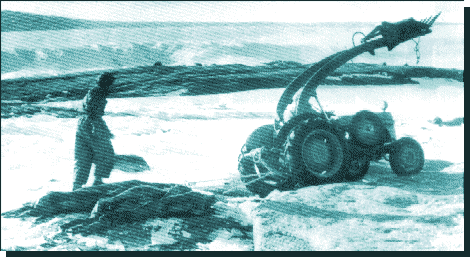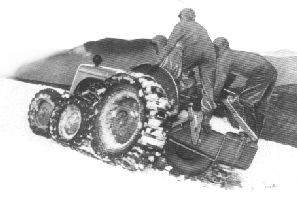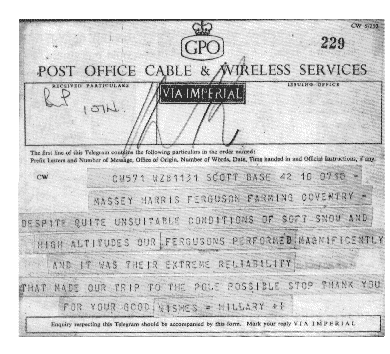| The Worst Journey in the World. |
An extract from The Friends of Ferguson Heritage magazine...
|
During 1954 a single
Ferguson TEA tractor had worked for 565 hours, without the need
to replace a single spare part in  the extreme cold
temperatures of the Antarctic. It assisted with the support role
of hauling of the stores, levelling the site for the huts,
lifting the hut sections into place, carting rock for infill,
stacking supplies, and even hauling seals which were the food for
the dogs. During this time the tractor remained outside for
twelve months without any protection from the weather, whilst it
helped to build the Antarctic station at Mawson.
the extreme cold
temperatures of the Antarctic. It assisted with the support role
of hauling of the stores, levelling the site for the huts,
lifting the hut sections into place, carting rock for infill,
stacking supplies, and even hauling seals which were the food for
the dogs. During this time the tractor remained outside for
twelve months without any protection from the weather, whilst it
helped to build the Antarctic station at Mawson.
The tractor was unloaded from the ship onto sea-ice on February 13th 1954 where the temperature was 10 below zero. It was then fitted with "Bombardier" half-tracks, which were required to pull the heavy loads, and give assistance with the winch which it also had, as it had to help to install a 21/4 ton generator. A high lift loader was another piece of Ferguson equipment which proved its worth with the erection of the prefabricated living accommodation, and a dozer blade for levelling the site and surrounding area.
The tractor was left outside and often became covered in snow and ice and although the temperatures fell to 42 below there were no starting problems. The battery was removed when the tractor was not in use, and the cooling system was filled with 50% Glycol, and a SAE5 oil was used in the engine and transmission: any thicker oil would have become solid in such low temperatures.
 Whilst the tractor was assisting with
the formation of the base it frequently had to traverse slopes
with loose scree and boulders and polished icy slopes of 1 in 9,
and 1 in 7 which it achieved without any difficulty, for which a
man needed ice picks and crampons, but the Fergie overcame with
ease.
Whilst the tractor was assisting with
the formation of the base it frequently had to traverse slopes
with loose scree and boulders and polished icy slopes of 1 in 9,
and 1 in 7 which it achieved without any difficulty, for which a
man needed ice picks and crampons, but the Fergie overcame with
ease.
February 1955 saw this famous tractor depart Antarctica and shipped back to Australia. In his report Mr John Russell the Australian expedition chief engineer officially recorded in his log "The tractor gave no trouble at all, it was outside throughout the twelve months without any weather protection. The terrain and working conditions are tougher than anyone would expect a machine to continue to operate upon with complete reliability." Further entries in the engineers log established that the tractors had not been given any gentle treatment.
The final job was to hoist upright a 90 foot sectional steel radio mast. By this time the Fergie had gained a reputation for being "an incredible little battler" and was becoming indispensable. The Australian Expedition frequently cried "For heck's sake bring up the Fergie". One correspondent likened the tractor to a "mountain goat" and after seeing it in action said "you've got that uneasy conviction that somewhere under that bonnet there lurks a brain." The same correspondent had witnessed the Fergie overturn and yet was back on the job, unscathed, within half an hour.
| ANTARCTICA
FACTS Situated at the southernmost point of the world, Antarctica comprises an area of about 5.5 million square miles. Larger than the United States of America, this vast, ice-covered continent is the coldest place on earth where the sun never rises for half the year and then, for the next six months, never sets. Even then, the temperature seldom rises above freezing. Frequent hurricane-force winds make the territory particularly inhospitable reducing visibility to almost zero. In spite of these conditions, explorations of the South Pole region started in earnest in the 19th Century, when only primitive equipment and simple transport was available to the explorers. The following summarises some of the key explorations.
|
The Commonwealth Antarctic Expedition decided in 1955 that due to the success of the Ferguson tractor that it would use Ferguson equipment to assist in the installation of their bases on each side of the Antarctic continent. The same decision was also taken by the Royal Society to use Fergusons which formed a part of the British contribution to the lnternational Geophysical Expedition Year. In both cases a range of implements to be used with the tractors was requested and included high lift loaders, winches, transport boxes, and small dozer blades.
Seven Tractors
Shipped
In the Autumn of 1956
seven tractors were shipped by the two expeditions, three diesel
versions (TEFs) went to Vahsel Bay for the use of the I.G.Y. Two
petrol models went to Shackleton for Dr Fuchs' party, with
another two to Scott Base for Sir Edmund Hillary's team.
Subsequently three more tractors were shipped from New Zealand by
the Massey-Ferguson distributors, Messrs C.B. Norwood, at the
request of Sir Edmund Hillary and two more of the New Zealand
I.G.Y. party. The three tractors used by Sir Edmund Hillary were
given by him to the U.S.A. scientists at the South Pole "in
return for an air lift home". These tractors were still
being used for seismic and glaciological studies sonic 300 miles
from the pole, in the Antarctic winter for half an hour a day in
temperatures between 80 to 90 below zero, some time after the
South Pole was reached.
For twelve months the Fergies had been used
around the bases with great success, but there were some concerns
regarding this farm tractor's capability to travel to the South
Pole.
By comparison there were some specialised vehicles which were
made in the U.S.A. known as the Sno-cats which had 200hp
industrial engines which were designed to cope with the harshest
polar conditions.
| The story continues to tell of how Fergusons reached the South Pole in The Ferguson Heritage Magazine, issues 12 and 13. We might put more on this page, if you're interested! |
|---|
 |
The famous telegram sent
by Sir Edmund Hillary following his arrival at the Pole. The use of Fergies was controversial and many people thought they would
not get further than 50 miles from base. Instead the tractors' reliability led Sir Edmund to suggest that it was now possible to
set up a regular tractortrain route between McMurdo Sound and the Pole.
|